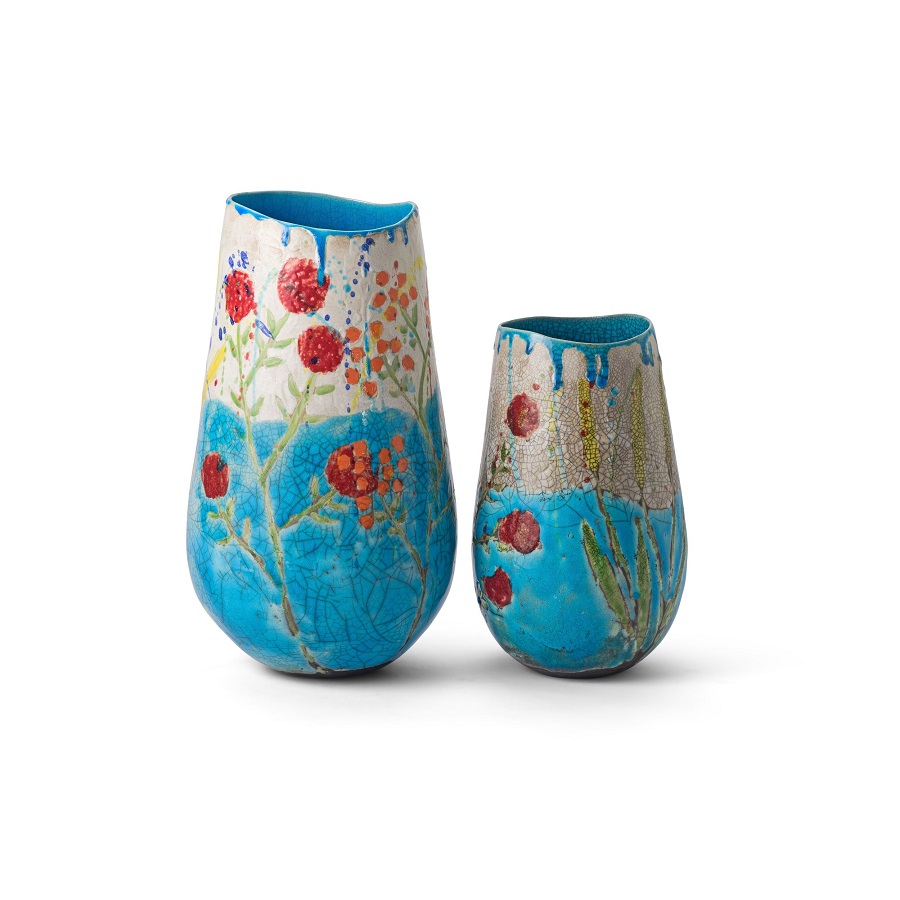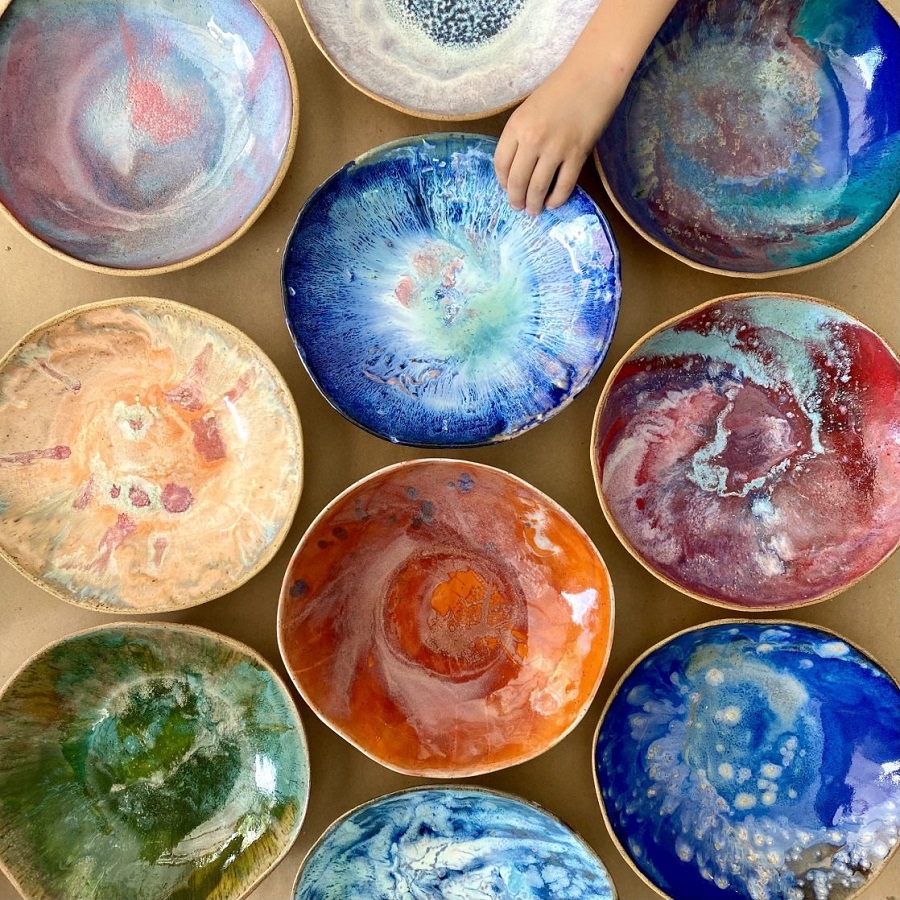The Origins of Ceramics: From Utility to Art
The history of ceramics began thousands of years ago. These early inventions arose from the need to store food and water. Communities molded clay by hand. They fired them in bonfires to create basic pots. This was the birth of pottery. Over time, people saw more than clay’s utility. They began to appreciate its potential for beauty.
Patterns etched into pots showed the start of ceramic art. Colors and shapes followed suit. The craft evolved from simple utility to complex art forms. As civilizations grew, so did the use of ceramics. They became items of trade and symbols of culture.
Early potters in different lands discovered the wheel. This led to rounder and more symmetrical wares. Kiln technology improved. It allowed higher firing temperatures. Glazes came into play, adding variety and durability. With each advancement, ceramics mirrored the sophistication of its makers.
Artisans of early societies often had special status. They held the knowledge of crafting ceramics. They passed the secrets of the trade from generation to generation. The tradition of ceramic art has carried through centuries. It tells the history of human innovation and expression. In this way, ceramics are a canvas of humanity’s evolution. They shifted from purely functional items to exquisite works of art. The history of ceramics reflects this transformation with each unearthed shard and intact vessel.

The Evolution of Ceramic Techniques Through the Ages
As centuries passed, the history of ceramics continued to unfold. Much like a potter molds clay, time shaped the evolution of ceramic techniques. The wheel improved craftsmanship greatly. It allowed for more precise shapes and intricate designs. Kilns, now central to pottery-making, saw numerous advances. They heated more evenly and to higher temperatures. This allowed for stronger, more durable ceramics.
Glazing was a major turning point in ceramic technology. Early glazes often contained lead, giving pottery a shiny, glass-like surface. Over time, potters developed varied glaze recipes. These included minerals that expanded the color palette. This evolution wasn’t just about aesthetics. It also improved ceramics’ ability to repel water and withstand time.
The introduction of porcelain in China is another key moment. Porcelain is made from a special white clay, called kaolin, fired at very high temperatures. This creates a material that is both delicate and strong. It quickly became highly prized, not just in China but across the world. This development spurred a new era of ceramic artistry.
Throughout the ages, molding techniques also refined. Potters shifted from coiling and pinching to slip casting. Slip casting allowed for more complex shapes. It became especially popular for creating intricate figurines and decorative items.
These advancements reflect a deepening human connection with the material world. Ceramics became a vessel for creativity, not just utility. They now told stories, carried traditions, and showcased skill. This evolution from basic containers to sophisticated art objects is central to the history of ceramics. It echoes the adaptability and innovation of human ingenuity.
Notable Ancient Civilizations and Their Ceramic Contributions
The history of ceramics paints a vivid picture of ancient civilizations. Each culture contributed unique styles and techniques. We see the ancient Egyptians, for example, mastering the art of faience. Their turquoise-glazed ceramics mimic precious stones. They often decorated tombs and temples with these works.
The Chinese civilization brought us porcelain. As mentioned, this is a testament to their high-temperature kilning mastery. This delicate yet robust material became a symbol of Chinese innovation.
The Greeks are known for their red and black figured pottery. These pieces tell us stories from their myths and daily life. Through these images, we gain insight into ancient Greek society.
Mesopotamia gives us some of the earliest examples of glazed bricks. These created dazzling facades on their ziggurats. It shows their pursuit of beauty in architecture.
The Mayans used ceramics in rituals and daily life. Their vibrant polychrome pottery stands out even today. They had skilled potters that shaped their strong cultural identity.
Each civilization’s ceramic legacy offers a glimpse into their world. These artifacts continue to speak of the skills and aesthetics of their creators. They tell us about resources, trade, and the advancements they made. The history of ceramics is richer for these contributions. It shows a universal commitment to the craft.

The Role of Ceramics in Daily Life and Cultural Practices
The history of ceramics is not only about artistry and technology; it deeply intertwines with daily life and cultural practices. Ceramics have held an essential role in domestic settings, serving functional purposes such as cooking, storage, and dining. From ancient water jugs to modern dinnerware, ceramics have been integral to household activities throughout history.
In many societies, certain ceramic forms carry significant cultural meaning. For example, tea cups in East Asia go beyond mere function. They are central to the ceremonial practices of tea-making and drinking. These rituals are steeped in tradition, respect, and community.
Religious and spiritual ceremonies also often incorporate ceramics. Incense burners, sacrificial vessels, and deity figurines are just a few examples. These items are not mere objects; they hold religious reverence and are crafted with intention and care.
Furthermore, ceramics bear witness to social customs. They may indicate status and wealth, as seen in the elaborate dinnerware sets of the European aristocracy. In contrast, simple earthenware suggests a more utilitarian and accessible approach, common within rural communities.
Lastly, gift-giving practices frequently feature ceramics. Handcrafted pottery can symbolize thoughtfulness and connection between the giver and the receiver. Whether they are exchanged during weddings, festivals, or as tokens of appreciation, ceramic gifts embody the human desire to share and connect.
The history of ceramics reflects the daily lives of individuals across generations. The material culture of ceramics shows how these objects are more than utilities; they are imbued with cultural significance, social values, and personal stories.
Ceramics in Architecture: A Legacy of Durability and Beauty
The history of ceramics spans not just the realm of handheld crafts but grand architecture too. Ancient builders often used ceramics for both functionality and aesthetic appeal. In architecture, ceramics stood the test of time due to their resilience and adaptability to various climates.
In Mesopotamia, shining glazed bricks covered the fa?ades of majestic ziggurats. These structures boast a blue hue that still captivates modern viewers. Imagine the grandeur these buildings held in their prime, with each brick’s glaze reflecting the bright sunlight.
The use of terracotta tiles is another example of ceramic durability. This material was not only practical for roofing but also brought warmth and character to buildings. Terracotta’s earthy tones and textures contribute to many iconic rooftops around the world. They grace homes and historical sites with a timeless charm.
Veering towards the decorative aspect, mosaic tiles tell stories from ancient civilizations. These small, colored pieces come together to form intricate patterns and images. They adorned the floors and walls of Roman villas and Byzantine churches. Mosaics remain a testament to the intricate artistry of past cultures. Their vibrancy and narrative potential continue to inspire contemporary designs.
The traditional azulejos of Portugal highlight human creativity with ceramics. These glazed, painted tiles depict scenes from history and folklore. They beautify buildings and often carry a piece of cultural identity on their surfaces.
Even today, architects and designers turn to ceramics when they seek durability and beauty. As part of the ongoing history of ceramics, modern buildings integrate ceramic elements. They add both function and form to urban landscapes. From durable cladding to expressive fa?ades, ceramics continue to leave a mark on our built environment. Their story in architecture is one of ancient roots growing into modern marvels.

The Influence of Trade on Ceramic Design and Distribution
The history of ceramics reveals trade’s deep impact. Trade routes spread ceramic goods across continents. This exchange enriched design diversity and shaped distribution methods. As potters traded, they shared techniques and styles. Such interaction led to a mixing of artistic influences, seen in pottery designs worldwide.
Trade was more than moving goods; it was about ideas and cultures mingling. For example, the famed Silk Road played a crucial role in distributing Chinese porcelain. This affected design practices in other regions, like the Middle East and Europe. Local artisans blended the porcelain styles with their own, creating unique fusion pieces.
In Europe, the rise of the Majolica technique showed this influence. Majolica, a tin-glazed pottery, borrowed from Islamic tin-glazed ceramics. It became prominent in Italy during the Renaissance. Potters adapted it to their tastes, adding vibrant colors and narratives in the designs.
The Delftware of the Netherlands is another result of trade influence. Inspired by Chinese blue and white porcelain, Dutch potters developed their version. Delftware became a sought-after item in Europe and beyond. This shows how trade can boost a local industry and widen a craft’s reach.
Trade networks facilitated the spread of materials like kaolin clay too. This key ingredient in porcelain reached different lands because of trade, helping potters elsewhere to explore this material’s qualities.
So, trade opened doors to new markets for potters. It led to the creation of iconic ceramic styles cherished around the globe. As commerce thrived, so did the distribution of ceramics. It shaped economies and brought the beauty of ceramics to all corners of the world.
Reviving and Preserving Traditional Ceramic Crafts
The history of ceramics isn’t simply in the past; it’s a living tradition today. Across the world, efforts to preserve and revive traditional ceramic crafts are growing. Here’s how heritage and dedication are shaping the future of ceramics.
Communities are returning to age-old techniques to keep their cultural heritage alive. They hold workshops and classes, passing on skills to new generations. This education ensures that the craft doesn’t become a lost art and remains a vibrant part of culture.
Artisans work together to maintain the quality of their crafts. They use local materials, as their ancestors did, keeping the connection to their land and history strong. These practices contribute to sustainable methods and support local economies.
Museums and cultural institutions play a key role, too. They exhibit ancient and traditional ceramics, telling their stories to a broader audience. These displays educate the public about the rich history of ceramics and its significance.
Festivals and markets offer artisans a platform to showcase their work. These events encourage appreciation for ceramic crafts, attracting enthusiasts and collectors alike.
Finally, governments and organizations sometimes provide grants or funding. They recognize the importance of preserving this part of cultural identity. With financial support, artisans can continue to create and sustain their work.
Together, these efforts keep traditional ceramic crafts alive. As guardians of an ageless art, today’s potters bridge the past and future, ensuring that the history of ceramics continues to thrive.
Modern Interpretations and Innovations in Ceramic Art
The history of ceramics not only honors the past but also opens doors to the future. Today’s ceramic artists blend traditional techniques with modern interpretations, creating innovative works that stretch the boundaries of the craft. The dynamic evolution of ceramic art is a testament to its enduring relevance in the contemporary art world.
Innovation in ceramics today is seen in many forms. Artists explore new shapes and textures, pushing the limits of clay and glaze. They challenge the conventional notion of ceramics being limited to functional items or classic forms. Sculptural ceramics break from tradition, showing that clay can be a medium for fine art.
Ceramics in the digital age have also benefited from technological advances. The advent of 3D printing has opened a new dimension in pottery making. Now, potters can design complex pieces on computers and print them in clay. This fusion of technology and art has led to unprecedented forms and designs.
Sustainability plays a major role in modern ceramics innovation. Artists are more conscious of their environmental impact. They often use recycled materials and eco-friendly processes. Some even incorporate organic elements, bringing nature right into their art pieces.
Collaborations between ceramicists and professionals from other disciplines lead to fresh perspectives. These partnerships can result in unique cross-disciplinary pieces that blend function and aesthetic in unexpected ways.
Finally, the contemporary history of ceramics is enriched by global influences. Artists draw inspiration from different cultures, creating a diverse tapestry of styles and narratives. These modern interpretations and innovations ensure that ceramic art remains as lively and significant as ever.